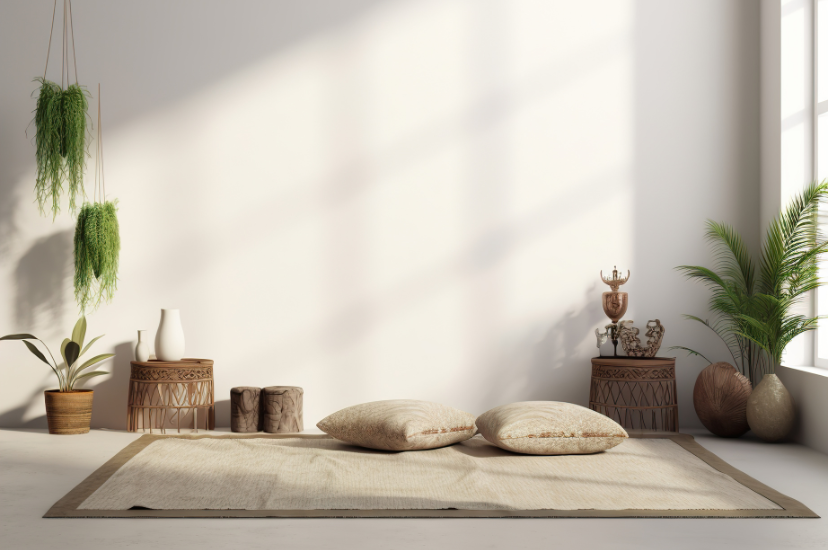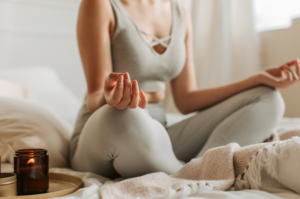In the evolving narrative of interior design, where beauty seamlessly merges with function, a refreshing ethos of mindfulness pervades our approach here at Paradox. We hold a deep-seated belief that our living spaces profoundly affect our emotional and mental well-being. Guided by this conviction, we endeavor to curate interiors that are not only visually appealing but also serve as sanctuaries that promote peace and introspection.
Embracing the Philosophy of Mindful Spaces

Mindful interior design transcends mere aesthetics—it’s about crafting environments that nurture tranquility and contemplative living. This approach involves selecting colors, textures, and layouts that resonate deeply, transforming homes into havens of calm and comfort amid the daily hustle.
- Create a Meditation Corner: Designate a small area in your home where you can practice mindfulness and meditation. Choose calming colors like soft blues or greens, add plush floor cushions or a comfortable chair, and incorporate elements of nature like plants or a small tabletop fountain to enhance tranquility.
- Declutter Regularly: Clutter can disrupt the flow of energy in a space and create feelings of stress or overwhelm. Make it a habit to declutter your home regularly, keeping only items that bring you joy or serve a practical purpose. Consider minimalist storage solutions to maintain a sense of openness and serenity.
- Introduce Natural Light: Maximize natural light in your home to uplift your mood and create a sense of spaciousness. Arrange furniture to allow sunlight to filter in, use sheer curtains or blinds to control glare, and strategically place mirrors to reflect and amplify natural light throughout the space.
The Alchemy of Color

The colors we surround ourselves with can dramatically shift our mood and outlook. Gentle, earthy tones can anchor and soothe us, offering a sense of security, while deeper shades like indigo or slate provide a rich, introspective backdrop. By thoughtfully integrating these hues, we create spaces that are not just striking but are also emotionally resonant.
- Use Color Psychology: Harness the power of color psychology to evoke specific emotions in different areas of your home. For instance, incorporate warm hues like soft yellows or oranges in social spaces to promote conviviality, while cool tones like blues or purples in bedrooms can encourage relaxation and restful sleep.
- Experiment with Accent Walls: Experiment with accent walls to add visual interest and depth to a room. Choose a bold color or striking wallpaper pattern for one wall to create a focal point without overwhelming the space. Balance the vibrancy of the accent wall with complementary neutral tones in the rest of the room’s decor.
- Layer Textures with Throws and Pillows: Enhance the sensory experience of your space by layering textures with throws and pillows. Mix and match fabrics like velvet, linen, and faux fur to add dimension and coziness to seating areas. Opt for complementary colors and patterns to create a cohesive and inviting atmosphere.
The Subtle Power of Texture

Texture adds depth and warmth to a space, inviting touch and interaction. Whether it’s the plush comfort of a thick rug underfoot or the crisp, clean lines of linen drapes, each textural element is chosen to encourage a tactile connection with our surroundings, enhancing the sensory experience of home.
- Invest in Quality Fabrics: Invest in quality fabrics for upholstery, curtains, and bedding to elevate the tactile experience of your home. Choose fabrics that are soft to the touch and durable, such as organic cotton, silk, or wool, to add a luxurious feel to your living spaces.
- Incorporate Natural Elements: Incorporate natural textures like wood, stone, and rattan into your decor to bring warmth and authenticity to your home. Consider adding wooden furniture pieces with rich grain patterns, stone accents like marble countertops or terrazzo flooring, and woven baskets or rugs for added texture and visual interest.
- Mix Textures Thoughtfully: Mix textures thoughtfully to create visual contrast and balance in your space. Pair rough textures like jute rugs or exposed brick walls with smooth surfaces like glass or polished metals to create a dynamic interplay of textures. Aim for a harmonious blend of textures that add depth and character to your home.
Furniture: Balancing Form and Function

In mindful interior design, furniture selection is a deliberate process where functionality meets elegance. Each piece should not only fulfill a practical purpose but also harmonize with the overall aesthetic. For example, a streamlined bookshelf can create a nook of clarity and order, while a deep, enveloping armchair beckons for relaxation and downtime.
- Choose Multifunctional Pieces: Maximize space and functionality by choosing multifunctional furniture pieces that serve dual purposes. Opt for a storage ottoman that doubles as a coffee table, a sofa bed for accommodating overnight guests, or a dining table with extendable leaves for hosting large gatherings.
- Prioritize Comfort: Prioritize comfort when selecting furniture for your home to create inviting and livable spaces. Invest in seating with ample cushioning and ergonomic support, such as a plush sofa with down-filled cushions or a cozy armchair with lumbar support. Don’t compromise on comfort for the sake of style.
- Scale Furniture to Fit the Space: Scale furniture to fit the proportions of your room to maintain balance and harmony. Avoid overcrowding smaller spaces with oversized furniture pieces that dominate the room. Instead, opt for appropriately sized furniture that allows for easy movement and circulation, creating a comfortable and functional layout.
Layout: Cultivating Flow

The arrangement of space profoundly influences its vibe and utility. Mindful design emphasizes ease of movement and clear pathways, fostering an atmosphere of freedom and fluidity. Thoughtful furniture placement can define zones of activity and repose, resonating with our innate rhythms of energy and rest.
- Create Clear Pathways: Ensure clear pathways and circulation routes throughout your home to facilitate ease of movement and flow. Arrange furniture to allow for unobstructed pathways between rooms and consider traffic patterns when placing larger pieces. Avoid cluttering walkways with unnecessary obstacles or furniture.
- Define Functional Zones: Define functional zones within open-plan spaces to delineate different areas of activity and promote a sense of organization. Use area rugs, furniture groupings, or architectural elements like half walls or columns to visually separate distinct zones for dining, lounging, and work or study.
- Encourage Social Interaction: Arrange seating arrangements to encourage social interaction and conversation among family members and guests. Create cozy conversation nooks with seating arranged in a circular or semi-circular configuration to facilitate face-to-face interaction. Position furniture to create intimate gathering spaces that foster connection and camaraderie.
Personal Touches: Echoes of the Self

Incorporating personal mementos, such as art pieces, family photos, or cherished collectibles, infuses a room with individuality and history. These elements weave a personal narrative into the decor, transforming a house into a home filled with stories and memories.
- Display Sentimental Objects: Showcase sentimental objects and personal mementos throughout your home to infuse it with your unique personality and history. Display family photos, heirlooms, or travel souvenirs on shelves or tabletops to create a sense of warmth and nostalgia that reflects your personal story.
- Curate Art Collections: Curate art collections that resonate with your interests, passions, and aesthetic preferences to add visual interest and depth to your home decor. Mix and match artworks in different mediums, styles, and sizes to create a dynamic gallery wall or focal point that sparks conversation and intrigue.
- DIY and Upcycle: Embrace DIY projects and upcycling to add a personal touch to your home while minimizing waste and environmental impact. Repurpose old furniture with a fresh coat of paint or upholstery fabric, create handmade artwork or decor accents, or embark on crafting projects that reflect your creativity and ingenuity.
Conclusion: Transforming Living Spaces into Life-enhancing Sanctuaries
At Paradox, mindful interior design transcends traditional decoration. It’s about creating spaces that not only captivate the eyes but also comfort the soul and foster well-being. By embedding mindfulness into our design philosophy, we help transform everyday living areas into nurturing sanctuaries that support and enrich life.
We invite you to reconsider your own spaces. Are they merely rooms, or are they retreats that inspire and rejuvenate? With mindfulness, every home can be a haven of harmony and personal renewal. The journey to transform your environment into a source of joy and peace is just a design decision away.




